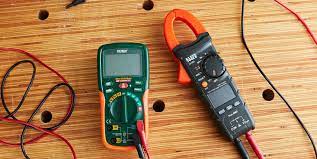Multimeters
A multimeter or a multitester, also known as a VOM (volt-ohm-milliammeter), is an electronic measuring instrument that combines several measurement functions in one unit. A typical multimeter can measure voltage, current, and resistance. Analog multimeters use a microammeter with a moving pointer to display readings.
Multimeter Types and Applications
Multimeter
A Multimeter is an electronic instrument, every electronic technician and engineers widely used piece of test equipment. A multimeter is mainly used to measure the three basic electrical characteristics of voltage, current, and resistance. It can also be used to test continuity between two points in an electrical circuit. This post mainly introduces the basic information of multimeters, applications, and types of multimeters are in. Let’s see all of these.
The multimeter has multi functionalities like, it acts like ammeter, voltmeter, and ohmmeter. It is a handheld device with positive and negative indicator needle over a numeric LCD digital display. Multimeters can be used for testing batteries, household wiring, electric motors, and power supplies.
Applications:
The applications of ammeter mainly involve in various electrical and electronic projects for components testing and also used in different measurement applications in the multimeter.
- Temperature and Environmental Applications
- Low-cost weather station
- DMM internal temperature
- Voltage Measurements
- High and low-value DC measurement
- Peak to Peak and DC average measurement
- Current Measurements
- DC measurement
- True RMS AC
- Resistance Measurement
- Micro ohmmeter
- Measuring resistance with constant voltage
- Measuring resistance with constant current
- Time and Frequency measurement
- Fast frequency
- Time measurement
Types of Multimeters:
There are different types of multimeters like Analog, Digital, and Fluke multimeters.
Digital Multimeter:
We mostly used multimeter is a digital multimeter (DMM). The DMM performs all functions from AC to DC other than analog. It has two probes positive and negative indicated with black and red color is shown in the figure. The black probe connected to COM JACK and red probe connected by user requirement to measure ohm, volt, or amperes. The jack marked VΩ and the COM jack on the right of the picture are used for measuring voltages, resistance, and for testing a diode. The two jacks are utilized when an LCD that shows what is being measured (volts, ohms, amps, etc.). Overload protection prevents damage to the meter and the circuit and protects the user.

The Digital Multimeter consists of an LCD, a knob to select various ranges of the three electrical characteristics, an internal circuitry consisting of a signal conditioning circuitry, an analog to digital converter. The PCB consists of concentric rings which are connected or disconnected based on the position of the knob. Thus as the required parameter and the range are selected, the section of the PCB is activated to perform the corresponding measurement. To measure the resistance, current flows from a constant current source through the unknown resistor and the voltage across the resistor are amplified and fed to an Analog to Digital Converter and the resultant output in form of resistance is displayed on the digital display. To measure an unknown AC voltage, the voltage is first attenuated to get the suitable range and then rectified to DC signal and the analog DC signal is fed to A/D converter to get the display, which indicates the RMS value of the AC signal. Similarly to measure an AC or DC, the unknown input is first converted to a voltage signal and then fed to an analog to digital converter to get the desired output(with rectification in case of AC signal).
Advantages of a Digital Multimeter are its output display which directly shows the measured value, high accuracy, ability to read both positive and negative values.
Analog Multimeter:
The Analog Multimeter or VOM (Volt-Ohm-Milliammeter) is constructed using a moving coil meter and a pointer to indicate the reading on the scale. The moving coil meter consists of a coil wound around a drum placed between two permanent magnets. As current passes through the coil, the magnetic field is induced in the coil which reacts with the magnetic field of the permanent magnets and the resultant force causes the pointer attached to the drum to deflect on the scale, indicating the current reading. It also consists of springs attached to the drum which provides an opposing force to the motion of the drum to control the deflection of the pointer.

For the measurement of DC, the D Arsonval movement described above can be directly used. However, the current to be measured should be lesser than the full-scale deflection current of the meter. For higher currents, the current divider rule is applied. Using different values of shunt resistors, the meter can also be used for multi-range current measurements. For current measurement, the instrument is to be connected in series with the unknown current source.
For measurement of DC voltage, a resistor is connected in series with the meter, and the meter resistance is taken into account such that the current passing through the resistor is the same as the current passing through the meter and the whole reading indicates the voltage reading. For voltage measurement, the instrument is to be connected in parallel with the unknown voltage source. For multirange measurement, different resistors of different values can be used, which are connected in series with the meter.
For measurement of resistance, the unknown resistance is connected in series with the meter and across a battery, such that the current passing through the meter is directly proportional to the unknown resistance.
For AC voltage or current measurement, the same principle is applied, except for the fact that the AC parameter to be measured is first rectified and filtered to get the DC parameter and the meter indicates the RMS value of the AC signal.
Advantages of an Analog Multimeter are that it is inexpensive, doesn’t require a battery, can measure fluctuations in the readings.
The two main factors affecting the measurement are sensitivity and accuracy. Sensitivity refers to the reciprocal of the full-scale deflection current and is measured in ohms per volt.
Fluke Multimeter:
The fluke multimeters are protected against the transient voltage. It is a small portable device used to measure voltage, current, and test diodes. The multimeter has multi selectors to select the desired function. The fluke MM automatically ranges to select most measurements. This means the magnitude of the signal does not have to be known or determined to take an accurate reading, it directly moved to the appropriate port for the desired measurement. The fuse is protected to prevent damage if connected to the wrong port.


There are a variety of multimeters for a number of different projects and services, and having the right one is the key to a convenient and easy job. While analog multimeters are still available on the market, and can provide a variety of different benefits, this article will be specifically focusing on the types and benefits of different digital multimeters. If you’re interested in both types of multimeters, check out our blog post that details the differences between digital and analog multimeters!
An Overview on the Function of Multimeters
Most digital multimeters can measure:
- Frequency.
- Conductance.
- Continuity.
- Inductance.
- Resistance.
There are, however, some more advanced models that can give you an even wider range of functions and measures. If you need something specific, and you’re working on a technologically-advanced construction, it’s recommended that you look for a multimeter that can measure:
- Decibels.
- Rotations Per Minute.
- Graphs and Graphing Capabilities.
- Microamps.
- Waterproof Capabilities.
Three Types of Digital Multimeters

A fluke digital multimeter is used mainly for calibration efforts. It can be used to calibrate volts, currents, and other electrical units.
A clamp digital multimeter uses built-in tools to measure electrical flow. This highly differs from the fluke digital multimeter in that it uses a clamp in order to measure this flow, and is usually only recommended for use by a professional.
An auto ranging digital multimeter is used for easier projects. This is the most highly recommended type for use by DIY enthusiasts and at-home electricians. It usually just measures one component at a time. Further details about these three types of multimeters will be broken down to help you understand what you may or may not be looking for in an electrical measuring device.
Fluke Digital Multimeter
Are you looking to calibrate the resistance and voltage usage of the electrical devices in your home or machines? A fluke digital multimeter uses its large display screen to help you measure resistance and voltage simultaneously.
Furthermore, you can use a fluke digital multimeter to access different functions per project. If you own an advanced multimeter, such as a new device from Mastech or Craftsman, it may come with the ability to measure the frequency, duty circle, shock, drop, pressure, humidity, and even temperature of your electrical components.
Fluke multimeters are most commonly used with HVAC units and car batteries. This is also the most sought-after type of multimeter not just for electricians, but for anyone looking to measure important components.
Our Tool Nerds team will typically recommend a fluke digital multimeter as a great place to begin, especially if you aren’t sure which type of digital multimeter you need to work with.
Since it provides a wide range of functions and capabilities, it can cover a number of important uses for your projects.
Clamp Digital Multimeter
The clamp digital meter can read such measurements as:
- Flow of Electricity
- Voltage
- Power Consumption
- Wattage
- Amps
Remember that you must pick the setting you wish to measure before you use the device; otherwise, it may pick up on the wrong reading.
Autoranging Multimeter

Which Digital Multimeters Test Which Components?
Digital multimeters are separated into the following categories:
- Category I – used for the testing of electronic devices and equipment.
- Category II – this is for testing appliances and domestic loads.
- Category III – for testing industrial circuits, typically of a small to medium-sized range.
- Category IV – this is for heavy-duty testing, such as for electrical power lines, residential feeds, and main electrical components for commercial areas.
Making the Switch from Analog to Digital

If you’re a long-time analog user, then making the switch to digital multimeters can be an overwhelming exchange. Getting used to the digital display screens, the variety of adjustable knobs, and the pre-programmed settings can make the device hard to handle. Our Tool Nerds experts recommend reading through our multimeter reviews to determine which of these handy tools would work best for you. If you want, you can test one out at your local hardware store. Whether you’re a seasoned electrician or a DIY enthusiast, you’ll find a variety of uses out of a digital multimeter.



